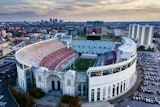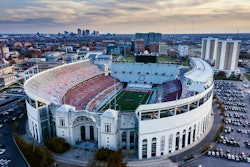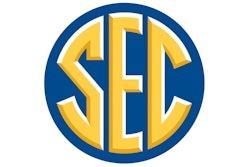Use these five steps - make that six steps to create an appropriate playground area for children.
Just as playgrounds don't simply fall out of the sky ready for children to use, they can't be developed merely by selecting equipment from a few catalogs.
Nor should playground equipment be selected because a manufacturer's representative is having a sale on certain items. Rather, the development of an appropriate playground area for children involves careful planning that can take more than a year. Fortunately, preliminary research and preparation help to pay dividends later.
As professionals consider planning playgrounds, the following steps can help administrators and/or community volunteers develop a logical and comprehensive strategy.
Step 1: Form a playground planning committee. The development of every playground needs to start with concerned individuals coming together to plan the play environment. Thus, the first step in the process is to form a playground committee of six to 10 people who represent various points of view and expertise. For example, in a park and recreation setting, the committee should include the recreation director, a park and recreation supervisor, a maintenance specialist, a park board representative, a city council member, at least one person who is knowledgeable about children with disabilities, someone interested in spearheading fund-raising efforts, and a parents' representative. From this group, elect a chairperson and secretary, and have the secretary keep meeting minutes that include topics discussed, decisions made and the names of individuals attending the meetings.
Step 2: Gather information. If feasible, contact someone neutral who is knowledgeable about playgrounds and can help facilitate the planning process. In cases in which the project is too small or the cost of a consultant too high, select a knowledgeable person in the community to help. This person may be a park and recreation professional, a nurse, a physical educator or a childcare consultant. If your area has a community college, college or university, you may be able to contact someone in the recreation, physical education, elementary education or child development disciplines, or a person who has expertise in playground development in a related department such as administration.
Playground equipment manufacturers' representatives or custom designers can also fulfill this role, although it is often best to rely on someone who has no vested interest in the type or brand of equipment that is eventually purchased. You may also consult the American Association for Leisure and Recreation (AALR), the National Program for Playground Safety (NPPS) or the National Recreation and Park Association (NRPA).
A consultant, if one is chosen, should attend the first or second meeting of the planning group. That individual can get the group organized, set tasks and lend rationale for the order of the planning process. It may be appropriate to pay the consultant a fee and/or cover his or her expenses, since a good consultant will provide information that should save money over the length of the project. In addition, send for at least 10 catalogs of playground equipment from different manufacturers, and 10 catalogs from surfacing companies. All companies should provide evidence that their materials or equipment meet Consumer Product Safety Commission (CPSC) guidelines and American Society for Testing and Materials (ASTM) standards, where applicable.
The point is, you need a broad perspective regarding what is available and the advantages and disadvantages of various materials and pieces of equipment. Do not rely on a single sales representative from only one company. Since you can choose to install equipment on the playground from more than one company, you'll need to see the breadth of options available.
Once the planning facilitator is on board, the committee should obtain written materials on playground safety in order to know what guidelines and standards should be met. There are three documents that are crucial to the planning process:
- The Handbook for Public Playground Safety, published by CPSC.
- The ASTM F-1487 Standard for Public Use Playground Equipment, published ASTM.
- The ASTM F-1292 Standard for Surfacing, also published by ASTM.
In addition, it is extremely important to ascertain the age levels for whom the playground is intended. As a result, adults must determine the developmental needs of the children who will use the playground. Three age-appropriate areas-2 and under, 2 to 5, and 5 to 12 - need to be considered. The areas need to be separated so play areas for each distinct usage group are away from the others. The concern is that younger children may be tempted to use equipment that is too big for them and in the process be injured because a grip is too large or a piece of equipment is too complicated for the intellectual level of the child. Playground standards for children ages 2 and under are currently being developed. (The CPSC handbook has guidelines for age-appropriateness of different pieces of equipment.)
You also need to remember to plan for all children. The U.S. Architectural and Transportation Barriers Compliance Board's interpretation of the Americans with Disabilities Act in relation to playgrounds is expected to be published soon.
However, all children, with and without disabilities, should have access to some playground structures. It should be understood that children with disabilities have more similarities to children without disabilities than they have differences, so plan accordingly.
If the play area will be a joint-use facility (for example, parks and schools), planning should incorporate the needs of both partners. Sometimes, one group will have stricter guidelines (such as guidelines mandated by the state) than the other. It is also critical that policies are clear regarding who will maintain the area and how frequently. You should always use the most stringent standards in the planning process to avoid problems when the facility opens for use.
Besides user-related considerations, you also need to evaluate the proposed site for the play area. This evaluation will better position the committee to decide what to retain, remove or fix in an existing play area; what to purchase to add to an existing play area; or whether to completely develop a new playground. This also may be a job for a qualified professional or consultant.
Lastly, there are a few other items that need to be researched during the information-gathering step. These include:
- Hazard analysis. Think about the accident-causing situations that cannot be seen or perceived by the user and how they can be handled.
- Legal issues. Check insurance company requirements on equipment, including the use of volunteers to install equipment or supervise children.
- A risk-management program. Determine who will create and file maintenance inspection sheets on a regular basis and where such information will be kept.
- Supervision. Decide training requirements for agency playground supervisors.
The result should be a conceptual framework consisting of values and outcomes-for example, "the activity of climbing is important"-rather than physical properties. Input at this stage should also be sought from children. Again, ask the children what they would like to do in the area (conceptual) rather than what equipment they would like to have (physical properties). Activities that both children and adults want incorporated into the playground may include cooperating, decision-making, running, climbing, socializing, exploring, manipulating and jumping.
Develop performance goals that you hope the playground will meet. For example:
- The play area must have separate subareas to accommodate the different age groups served.
- Younger children must have opportunities to manipulate various textures.
- Older children must have opportunities to cooperate.
Step 4 - Put concepts into action. Send your preliminary information to at least three companies for plans and quotes. Have the companies send back to you a plan, estimated costs and a detailed rationale regarding ways that their plan meets your goals. Do not accept a plan without the companies' rationale for meeting your goals; do not assume a plan without rationale will meet your needs. Request the vita of the designer for the company. If there is no evidence of knowledge of children noted, consider using another company.
If you are utilizing the services of a neutral consultant or designer, you need to have him or her view the plans. The designer should indicate how your goals are going to be met, not how the designer's thoughts are being carried out. Remember, this is a playground that you and children you care about will be using long after the designer has gone on to the next project. Form a budget after the site has been evaluated, children's needs have been assessed and catalogs have been consulted.
The fund-raising chair should be included in this discussion. The budget should include the cost of a shockabsorbent surface, as well as the equipment, installation, fencing (if appropriate) and ongoing maintenance for the entire playground. In case it wasn't apparent earlier, this is why it is important for the fund-raiser to have attended the meetings. The fund-raiser must understand the rationale for the selection of the equipment and surfacing.
Note, also, that the budget and fundraising activity does not occur until a plan is in place. People do not give to ideas; they give in order to get things. They give, in other words, for concrete rather than abstract principles.
Develop a fund-raising plan and schedule. Many companies will accept a payment arrangement in which money is paid up front and at the end of the project. This needs to be negotiated prior to any construction.
Step 5-Actualization. Obtain and verify instructions for installation and maintenance from the equipment and surfacing companies you've selected. If you are installing equipment in-house, make sure that the company representative is present to give guidance for proper installation. If you contract out for the installation, verify the credentials of the installer. At the completion of the installation, it is important to do an audit to validate the safety of the playground prior to final payment.
Implement a file system to document decisions that have been made, maintenance work and the assessment report. This may be incorporated with the other risk-management documents. Train supervisors on the proper use of equipment. Review the supervision plan with individuals assigned to watch the children in the different play areas. Don't forget to teach children proper use of the new equipment. Review rules for the use of equipment with children at least once per year. In addition to supervision provided by park personnel in community settings, make sure that signage is present indicating expected play behavior, rules for using equipment and the ages of children for whom the equipment is designed. Also, it is important that the sign indicates the importance of adults supervising children while children use the equipment. After all, the equipment will not supervise the children.
Step 6 - Plan a celebration. Invite committee members, board members, contributors, press and children to come to the grand opening. Sponsor a food event and ribbon cutting in order to open the playground for general use. Then, let the children play.




































